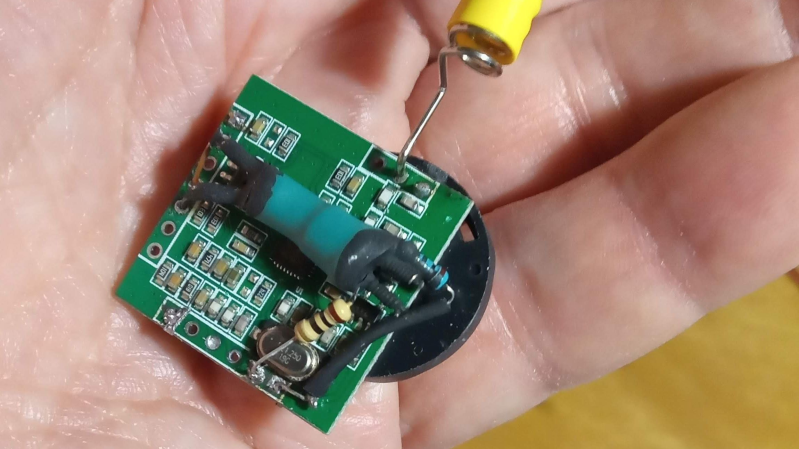[Jim Matthews] submitted his Ham Radio foxhunt transmitter project for the 2025 One Hertz Challenge.
This is a clever Spartan build. In order to create a radio beacon for use in a “fox hunt” [Jim] combined a SR-T300 walkie talkie module with a phototransistor and oscillating LED circuit. The phototransistor and oscillating LED are secured face-to-face inside heat shrink tubing which isolates them from ambient light. When the LED flashes on the phototransistor powers the radio which transmits a tone in the UHF band.
A fox hunt is a game played by radio enthusiasts in which players use radio signals to triangulate and find a hidden beacon. [Jim]’s circuit is the beacon, and when it’s powered by a three volt CR2032 battery, it transmits a strong signal over several hundred yards at 433.5 MHz, within the amateur radio UHF band.
If you’re interested in radio beacons you might like to read about the WSPR beacon.
















Interesting! Here in Germany, fox hunting (foxoring) is common on 80m band.
Often done via homebrew receivers.
Foxes without a proper CW ID are so-called training foxes, I think.
They’re basically an 3,57 MHz oscillator with a blinken light as a keyer.
Back in the early days a simple incandescent lamp with bi metal was used (blinking type).
The real foxes are using a diode matrix, EPROM or microcontroller to make the ID (such as P1, P2, P3).
They were used in fox hunts were you could get your diploma.
For serious sports, if you will. The simpler units were “just for fun”.
Amateur radio direction finding (ARDF) also called radio orienteering and foxhunting, has several types of races on 2 bands: on 144MHz (2m band) there is a classic 5 transmitters race, each transmitter works for 1 minute and then they cycle; on 3.5MHz (80m) there are classic race (same as on 2m band), sprint race (2 sets of 5 transmitters – sets work on different frequencies, and each set has cycling transmitters which transmit for 12s (so 12s of work – 48s of silence), and the last and most interesting for this article foxoring (10 or more low power transmitters which work contionously).
The simplest foxoring transmitters do use a 3.579MHz oscillator (the crystal is readily available as it’s used as NTSC colorburst frequency) and a blinkenlight (usually a decade counter and some diodes) for activation. The official rules allow only for about 100 meter range, so the transmitters are in a miliwat range.
Sprint and especially classic races do have a microcontroller for controlling the time and transmitting ID – in the old days it was EPROM but the price and complexity of those in compare to microcontrollers just pushed them out. The complexity of those is bigger, but nothing that a hamradio operator isn’t used to.
The identifiers are MOE ( – – – – – .) , MOI ( – – – – – . .) , MOS ( S is . . . ), MOH (H is . . . .) and MO5 (5 is . . . . .), although for local foxoring races some clubs/countries just one Morse letter is used for transmitter ID. Additionally, as some countries require the ID of the operator, at the end of the cycle the transmitter sends operator callsign.
I don’t think the simpler units are “just for fun”. Foxoring transmitters are used as basic tools for learning of soldering and theory in hamradio youth classes/camps, as an experimental boards for teaching propagation and antenna work, and for introducing kids and adults into ARDF – it’s rather simple to setup 3 transmitters working on different frequencies in a local park, and let people try to find them. It can be loads of fun!
As such, the device in the article can be a nice little game for kids to understand how antennae work, and how to use a PMR/hamradio 432MHz device..
Very good write-up! Well done! 😃👍
I wonder where the law sits with these beacons.
Transmitting a continuous stream of beeps for potentially hours of days might count as interference. I’d guess you may well still need an amateur radio licence for certain frequencies.
Probably. The 433 MHz band was allocated to LPD, but also used by radio amateurs.
About 20 years ago, there was the possibility for both groups to technically talk to each others, but it wasn’t allowed.
https://en.wikipedia.org/wiki/LPD433
Okay, so I dug a little bit deeper.
It seems that 433 MHz also has ISM band, the “scrapyard band”, so to say.
Just like it’s with 27MHz/11m band, which has CB radio and ISM, too.
On ISM in the odd channels, all the weird things can happen.
Door bells, RC cars, garage openers, baby phones. Why not radio foxes, too?
Another, earlier 433 MHz fox hunt project: http://www.flohjagd.de/
In the US at least, you can use amateur radio frequencies as long as your beacon transmits your call sign in a somewhat-standard way. I think CW / morse code is the most common. There’s no AM, FM, PSK, or any other encoding involved — the device just turns the transmitted on and off at the appropriate times.
There are also CW and ISM bands, which can be used to varying degrees by unlicensed amateurs — but in that case, the transmitter must be licensed and you aren’t allowed to build your own from scratch.
I gotta watch that damned autofill :/
LOL – autofills almost lost me the job I have now !